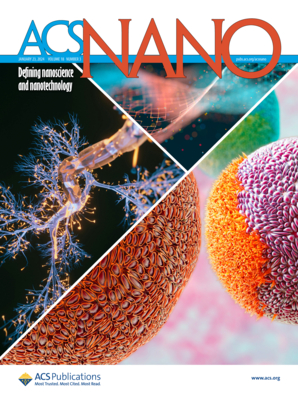Small-Molecule Self-Assembly Strategy for Ultrafast, Sensitive, and Portable Multiplexed Antibiotics Detection by Transistor Biosensor Arrays
IF 15.8
1区 材料科学
Q1 CHEMISTRY, MULTIDISCIPLINARY
引用次数: 0
Abstract
The urgent need for portable, sensitive, and accurate techniques to analyze multiple antibiotics is critical to mitigating the health risks associated with low-dose antibiotics coexposure-induced drug resistance, especially in infants. Emerging field-effect transistor (FET) biosensors are expected to realize the above requirement, but face challenges in terms of sensitivity and selectivity for complex solutions in practical applications. Here, we introduce a small-molecule coating strategy on carbon nanotube (CNT)-FET biosensor arrays to simultaneously block nonspecific adsorption and minimize Debye shielding effects, coupled with aptamer for antibiotics recognition through inkjet printing technology, which significantly improves the selectivity and sensitivity. The developed portable detection system with the FET biosensor chip displayed an ultrafast response time of 100 s, high sensitivity at the femtomolar level for both simultaneous detection and quantification of multiple antibiotics (kanamycin, oxytetracycline, and sulfaquinoxaline), a wide linear range from femtomolar to nanomolar concentrations, and exceptional accuracy, with a recovery rate of 91.1 to 107.5%. This work presents a biosensor array that can quantify various antibiotics at extremely low concentrations in milk samples, is superior to the enzyme-linked immunosorbent assay (ELISA) method, and can also be applied for the detection of other biomarkers, such as toxins and hormones.

求助全文
约1分钟内获得全文
求助全文
来源期刊

ACS Nano
工程技术-材料科学:综合
CiteScore
26.00
自引率
4.10%
发文量
1627
审稿时长
1.7 months
期刊介绍:
ACS Nano, published monthly, serves as an international forum for comprehensive articles on nanoscience and nanotechnology research at the intersections of chemistry, biology, materials science, physics, and engineering. The journal fosters communication among scientists in these communities, facilitating collaboration, new research opportunities, and advancements through discoveries. ACS Nano covers synthesis, assembly, characterization, theory, and simulation of nanostructures, nanobiotechnology, nanofabrication, methods and tools for nanoscience and nanotechnology, and self- and directed-assembly. Alongside original research articles, it offers thorough reviews, perspectives on cutting-edge research, and discussions envisioning the future of nanoscience and nanotechnology.
 求助内容:
求助内容: 应助结果提醒方式:
应助结果提醒方式:


